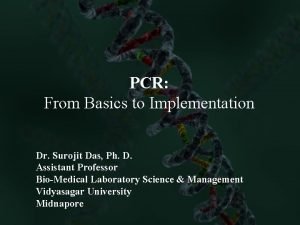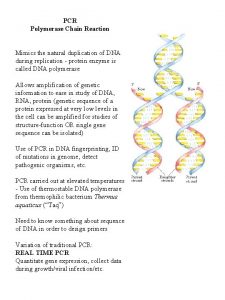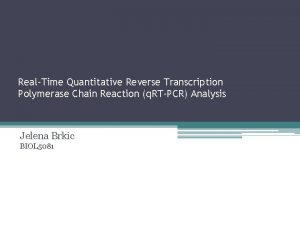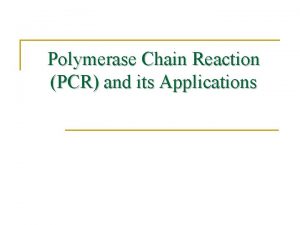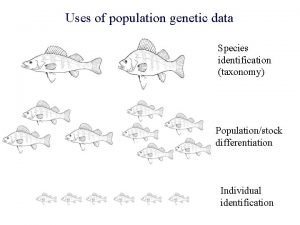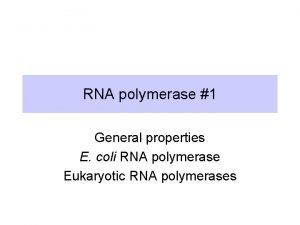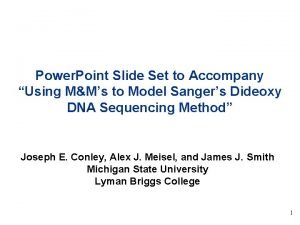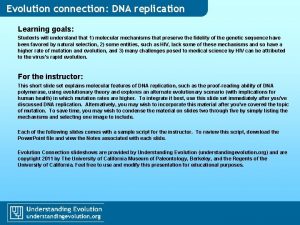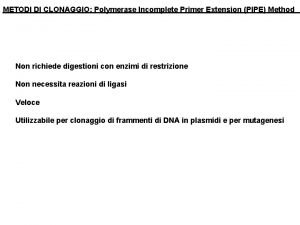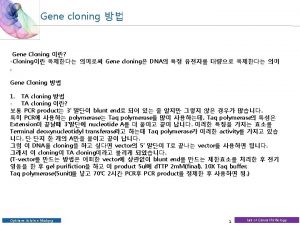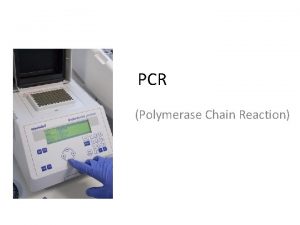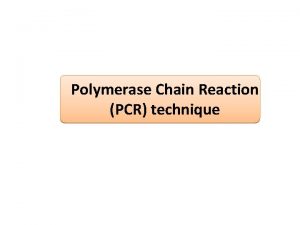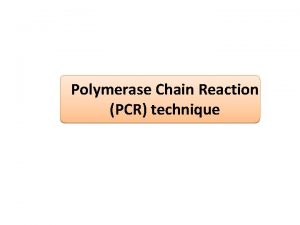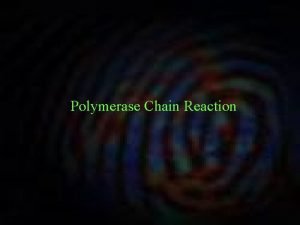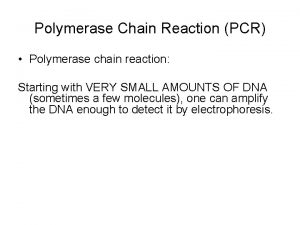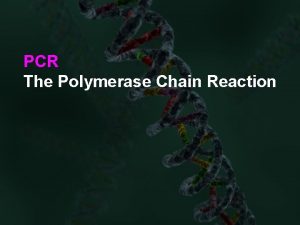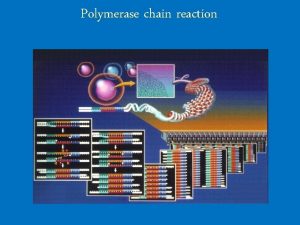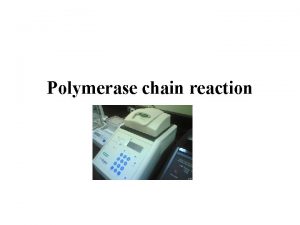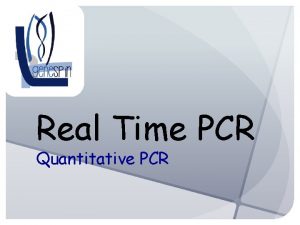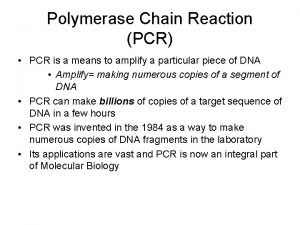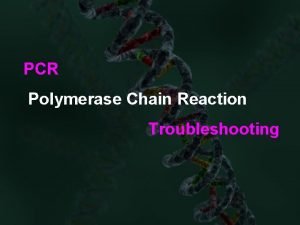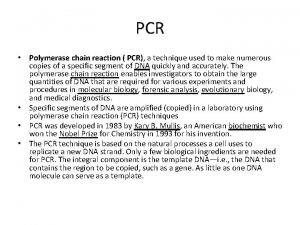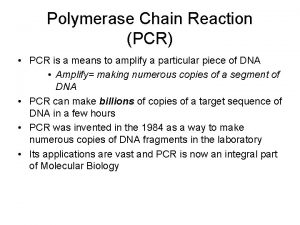Polymerase Chain Reaction What is PCR Why Polymerase






























- Slides: 30

Polymerase Chain Reaction

What is PCR? : Why “Polymerase”? It is called “polymerase” because the only enzyme used in this reaction is DNA polymerase.

What is PCR? : Why “Chain”? It is called “chain” because the products of the first reaction become substrates of the following one, and so on.

1966, Thomas Brock discovers Thermus Aquaticus, a thermostable bacteria in the hot springs of Yellowstone National Park 1983, Kary Mullis postulated the concept of PCR ( Nobel Prize in 1993) 1985, Saiki publishes the first application of PCR ( beta-Globin) 1985, Cetus Corp. Scientists isolate Thermostable Taq Polymerase (from T. Aquaticus), which revolutionized PCR

• PCR, polymerase chain reaction, is an invitro technique for amplification of a region of DNA whose sequence is known or which lies between two regions of known sequence • Before PCR, DNA of interest could only be amplified by over-expression in cells and this with limited yield

What is PCR? : The “Reaction” Components 1) Target DNA - contains the sequence to be amplified. 2) Pair of Primers - oligonucleotides that define the sequence to be amplified. 3) d. NTPs - deoxynucleotidetriphosphates: DNA building block 4) Thermostable DNA Polymerase - enzyme that catalyzes the reaction 5) Mg++ ions - cofactor of the enzyme 6) Buffer solution – maintains p. H and ionic strength of the reaction solution suitable for the activity of the enzyme

The Reaction PCR tube THERMOCYCLER

Denature (heat to 95 o. C) Lower temperature to 56 o. C Anneal with primers Increase temperature to 72 o. C DNA polymerase + d. NTPs

Reaction Components • • • DNA template Primers Enzyme d. NTPs Mg 2+ buffers

1 - DNA template • DNA containing region to be sequenced • Size of target DNA to be amplified : up to 3 Kb

2 - Primers • 2 sets of primers • Generally 20 -30 nucleotides long • Synthetically produced • complimentary to the 3’ ends of target DNA • not complimentary to each other

Primers (ctnd) • Not containing inverted repeat sequences to avoid formation of internal structures • 40 -60% GC content preferred for better annealing • Tm of primers can be calculated to determine annealing T 0 • Tm=. 41(%G+C) + 16. 6 log(J+) + 81. 5 where J+ is the concentration of monovalent ions

3 -Enzyme • Usually Taq Polymerase or anyone of the natural or Recombinant thermostable polymerases • Stable at T 0 up to 950 C • High processivity • Taq Pol has 5’-3’ exo only, no proofreading

The PCR Cycle • Comprised of 3 steps: Denaturation of DNA at 950 C - Primer hybridization ( annealing) at 40500 C - DNA synthesis ( Primer extension) at 720 C

• http: //ocw. mit. edu/NR/rdonlyres/Civil-and-Environmental-Engineering/1 -89 Fall-2004/321 BF 8 FF-75 BE-4377 -8 D 74 -8 EEE 753 A 328 C/0/11_02_04. pdf






Standard thermocycle

Detection of amplification products • • Gel electrophoresis Sequencing of amplified fragment Southern blot etc. . .

Molecular Identification: Detection Of Pathogens Sensitivity of detection of PCR-amplified M. tuberculosis DNA. (Kaul et

Applications of PCR • Classification of organisms • Genotyping • Mutagenesis • Mutation detection • Sequencing • Cancer research • Detection of pathogens • DNA fingerprinting • Drug discovery • Genetic matching • Genetic engineering • Pre-natal diagnosis

MOLECULAR IDENTIFICATION:

Molecular Identification: Detection Of Pathogens

Summary blood, chorionic villus, amniotic fluid, semen, hair root, saliva 68, 719, 476, 736 copies Gel Analysis, Restriction Digestion, Sequencing

Conclusion The speed and ease of use, sensitivity specificity of PCR essential tool of molecular biology and made PCR the most widely used and powerful technique with great spectrum of research and diagnostic applications.

Applications • Genome mapping and gene function determination • Biodiversity studies ( e. g. evolution studies) • Diagnostics ( prenatal testing of genetic diseases, early detection of cancer, viral infections. . . ) • Detection of drug resistance genes • Forensic (DNA fingerprinting)

Advantages • Automated, fast, reliable (reproducible) results • Contained : (less chances of contamination) • High output • Sensitive • Broad uses • Defined, easy to follow protocols
 Pcr application
Pcr application Polymerase chain reaction
Polymerase chain reaction Polymerase chain reaction
Polymerase chain reaction Site:slidetodoc.com
Site:slidetodoc.com Pcr phases
Pcr phases Polymerase chain reaction
Polymerase chain reaction The three steps of polymerase chain reaction
The three steps of polymerase chain reaction Hey hey bye bye
Hey hey bye bye Food chain food chain food chain
Food chain food chain food chain Dont ask why why why
Dont ask why why why Reaction rate equation
Reaction rate equation E1cb elimination reaction
E1cb elimination reaction Leukoerythroblastic reaction vs leukemoid reaction
Leukoerythroblastic reaction vs leukemoid reaction Difference between nuclear reaction and chemical reaction
Difference between nuclear reaction and chemical reaction Rna polymerase 1 2 3
Rna polymerase 1 2 3 Proofreading and repair of a dna strand occurs during:
Proofreading and repair of a dna strand occurs during: Dna prokaryot
Dna prokaryot Replication fork
Replication fork Helicaee
Helicaee Types of dna polymerase in eukaryotes
Types of dna polymerase in eukaryotes Types of dna polymerase in eukaryotes
Types of dna polymerase in eukaryotes Dna polymerase
Dna polymerase Transcription initiation in eukaryotes
Transcription initiation in eukaryotes Dna polymerase
Dna polymerase Gapdh size
Gapdh size Rna polymerase
Rna polymerase Polymerase incomplete primer extension
Polymerase incomplete primer extension Adn polymérase
Adn polymérase Tth polymerase rtpcr
Tth polymerase rtpcr Dna polymerase
Dna polymerase What role does dna polymerase play in copying dna?
What role does dna polymerase play in copying dna?
